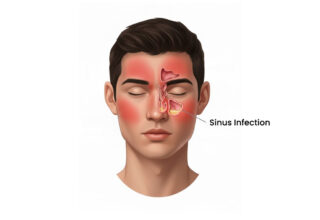Pulmonary fibrosis is a serious lung disease that gradually damages the lungs and makes it increasingly difficult to breathe. It makes it hard for your lungs to expand and deliver enough oxygen to your body. This condition can be idiopathic, which means it has no known cause, or it can be caused by factors such as autoimmune diseases, environmental exposure, or certain medicines.
In this blog, we are going to discuss key aspects of pulmonary fibrosis, including causes of pulmonary fibrosis, its symptoms, risk factors, complications, available treatment options, and preventive strategies.
What is Pulmonary Fibrosis?
It is a type of Interstitial lung disease (ILD) that causes damage and scarring (fibrosis) of lung tissue, affecting the tissue between the air sacs in the lungs (alveoli). This thickened and stiff tissue makes it hard for lungs to work properly and makes breathing difficult.
It is a permanent disease that typically progresses over time. As the disease advances, patients may experience worsening shortness of breath.
While some people may stay stable for a long period, others may experience a rapid decline. The rate at which it worsens can vary greatly from person to person.
What are the Causes of Pulmonary Fibrosis?
In many cases the exact cause is unknown. These cases are called Idiopathic pulmonary fibrosis (IPF). However in other cases, causes of pulmonary fibrosis can be;
-
- Environmental and Occupational exposure. These include long term exposure to pollutants like; silica dust, asbestos fibers, coal dust, grain dust, bird and animal droppings
- Connective tissue diseases. These include Rheumatoid arthritis, Systemic lupus erythematosus (SLE) , and scleroderma
- Granulomatous diseases. Such as sarcoidosis, Langerhans cell histiocytosis
- Certain medicines can also damage the lungs. These medicines include chemotherapy drugs such as methotrexate, bleomycin and cyclophosphamide, some heart medicines such as amiodarone, some antibiotics such as nitrofurantoin, certain anti-inflammatory medicines such as rituximab
- Radiation therapy. Radiation to the chest (e.g. breast or lung cancer) can cause lung damage months or years after treatment
- Certain viral or bacterial infections may trigger lung inflammation leading to fibrosis
- Smoking
Learn more about smoking and respiratory problems
What are the Symptoms of Pulmonary Fibrosis?
Typical symptoms of pulmonary fibrosis include;
- Shortness of breath (dyspnea). Initially it is during or soon after exertion but gradually it worsens affecting everyday activities like walking or climbing stairs
- Persistent dry cough
- Fast shallow breathing
- Fatigue
- Joint and muscle pain
- Loss of appetite
- Unintended or unexplained weight loss
- Clubbing of fingers or toes (rounded and swollen tips)
- Chest discomfort
Risk Factors:
Here are some risk factors that increases the chances of developing pulmonary fibrosis;
- Age 65 or older
- Male gender
- Smoking
- Family history of IPF or lung disease
- Jobs with exposure to dust, chemicals, and fumes
- Certain genetic mutations
Complications:
Complications of pulmonary fibrosis may include;
- High blood pressure in the lungs
- Respiratory failure
- Right sided heart failure
- Lung cancer
- Other lung diseases like lung infections or a collapsed lung
Diagnosis:
Pulmonary fibrosis is usually diagnosed through a combination of tests including;
- Chest X-rays
- High resolution CT scan (HRCT)
- Pulmonary function tests (PFTs)
- Blood tests including arterial blood gases
- Bronchoscopy
- Lung biopsy
Management & Treatment:
Pulmonary fibrosis currently has no cure. Treatment is aimed at relieving symptoms, slowing the progression of disease, and improving overall quality of life.
Treatment options for pulmonary fibrosis may include;
- Antifibrotic drugs like nintedanib and pirfenidone. These can help slow the progression of lung scarring and help maintain lung functions
- Corticosteroids. These may be prescribed to reduce lung inflammation in certain cases
- Oxygen therapy. If your oxygen levels are low, your healthcare provider may recommend supplemental oxygen delivered through nasal cannula or face mask to ensure your body gets the oxygen it needs
- Pulmonary rehabilitation. It is a program that combines breathing exercise, education, and physical therapy to strengthen the lungs
- Lung transplant. In advance cases, some patients may qualify for lung transplant
- Additionally, you may require medications to manage underlying conditions such as autoimmune diseases, and other contributing factors like gastroesophageal reflux disease (GERD), that can worse lung scarring
Prevention:
While not all cases can be prevented, certain lifestyle and environmental changes can decrease your risk of developing this condition.
- Wear protective gear if you work in dusty or chemical-laden environments.
- Avoid smoking or quit if you smoke.
- Stay up-to-date with flu and pneumonia vaccines to prevent lung infections.
- Go for regular medical check-ups for early detection by routine screening, especially those at high risk.
When to See Your Doctor:
You should see your healthcare provider if you experience increased shortness of breath or find yourself becoming unusually tired during routine activities. Early detection and treatment can help slow down the progression of lung disease.
If you have connective tissue disorder or granulomatous disease, ask your doctor if there are any steps you can take to lower your risk of developing pulmonary fibrosis.
Final Thoughts:
Pulmonary fibrosis is a progressive, nearly always permanent, and life-limiting lung disease. However, early detection of symptoms can make a significant difference in treatment and overall quality of life. If you or someone you know experiences persistent shortness of breath or chronic cough, contact your healthcare provider promptly. While there is no cure, modern treatment options can help manage this condition and slow its progression.








